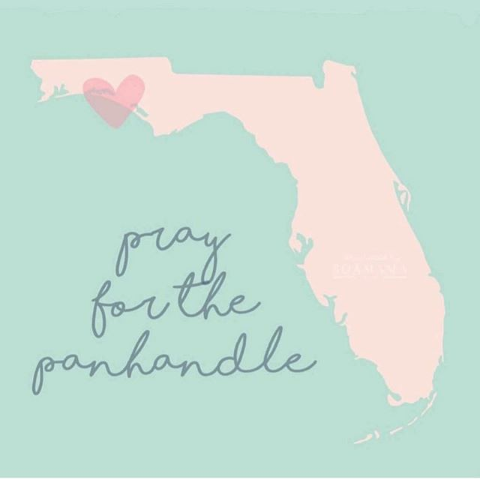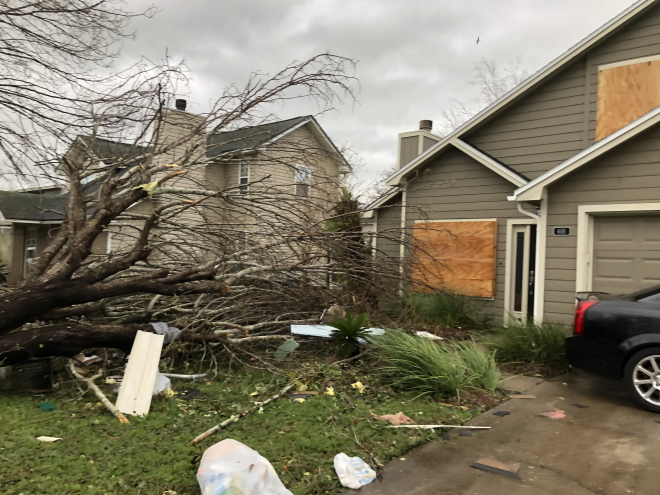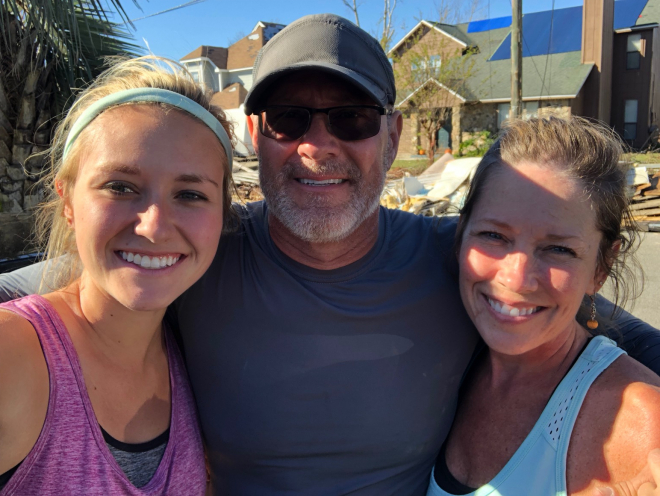How To Be Hurricane Ready with T1D
Adequately prepared
At the age of 6, I was diagnosed with type 1 diabetes, and now I have been a person with type 1 diabetes (T1D) for 18 years. I have always felt that over these years I have overcome obstacles and achieved accomplishments. For starters, I have lived 18 years with a chronic illness, what else can I say about that? I graduated nursing school with my RN license at the age of 21, graduated with my Bachelor’s degree, and then at the age of 22, I began a doctorate program to become a nurse practitioner. But everything that life had prepared me for didn’t prepare me for what was going to happen in October 2018.
Hurricane Michael was the FIRST Category 5 Hurricane to ever hit the Florida Panhandle. For my whole life I have lived in the Florida Panhandle—specifically Panama City. I have always been prepared for hurricanes, or at least known what to expect. To a Floridian, a hurricane is usually a day off from school or work due to bad weather and sometimes we wouldn’t even end up having that bad weather and would just get a free day off. The Panhandle has been very lucky with what has come our way, and we’ve never had a direct hit—until October 2018 that is.
The night in question
This storm suddenly appeared overnight, one day it was a tropical storm and the next day it was a hurricane… and then it hit. Many people in our area weren’t planning to leave, once again we are Floridians. And in our defense, we had no time to prepare for this storm. Three days maximum to prepare for a hurricane is not a timeline for proper hurricane readiness at all. The weekend before it hit, the fair was in town, I went to the zoo, and I avoided my school responsibilities because I was just happy to have a weekend off. Then on Tuesday, the whole town seemed to shut down at noon. Panama City Beach was under a mandatory evacuation, while the town was not. Businesses closed. Groceries sold out of food. And Hurricane Michael was a Category 3.
As far as my family was concerned, our plan was always to evacuate if the storm became bigger than a Category 3, so we were watching it closely. However, by eleven o’clock that Tuesday evening, right before I went to bed, it became a strong Category 4, and we were worried. After a not-so-restful sleep, we woke to see it was still our worst fear: a strong Category 4. Knowing we were sitting ducks until it was to pass, we did all we could to occupy ourselves until the destruction began.
To make a long story short, the hurricane only intensified once it hit land and ultimately was a Category 5 at the time it hit. During this, I watched my childhood home be destroyed, part of the roof rip off, flooding from the second story down to the first, along with collapsing ceilings throughout the house. What came after that morning on October 10, 2018, are events that I will never forget, and lessons that I learned (especially as a T1D in a natural disaster zone). I hope that no one ever has to endure what myself and my family went through. But if I can do one thing, I want to help other T1D’s out there that might be in harm’s way one day and could use the advice that I learned.
My tips

1. You may not have electricity, so charge your meter. For some strange reason, this thought hit me the night before the storm. I thought to myself, are all my meters charged? If we don’t have power, and my meter dies, then how will I check? Of course, I have been a T1D since the dark ages (aka before chargeable meters), so this is something I’m still adjusting to. That night, I plugged in all three of my meters and let them charge all night long. Thankfully, I did this because not only were we without power, but we were without power for over three weeks.
2. Stock up on supplies like it’s the last thing you do. I always thought over the years that my Mom kept a great stockpile of supplies like we were preparing for the end of days. I also always thought that her efforts would never come in handy (sorry, Mom). However, through this I learned that not only is it good to have a stockpile of supplies, but you should have at least a month of supplies saved up. Due to the catastrophic circumstances, we didn’t get mail for well over a month. Do you know how exciting it was to see a mailman after that? So, if you don’t have enough supplies, and can’t receive mail, that means no supplies. It doesn’t hurt to have extra of everything. Insulin. Reservoirs. Infusion sets. Sensors. You name it. Not to mention keep a good stockpile of alcohol swabs to clean infusion site changes and blood sugar checks, because showers don’t happen either during this time (gross, I know).
3. All supplies should be kept together. So, most of the supplies I had were together, some were in a closet, some in my bedroom, and some in a drawer somewhere else. The problem with this is that during the storm, once we lost part of our roof, we realized that with the flooding that was occurring in the house, meant that all the stockpile of supplies we had could possibly get damaged. This led to us, in the middle of the hurricane while 150+ mile per hour winds were gusting by the house, trying to frantically grab everything T1D-related I own.
We ended up throwing all supplies in pillow cases and whatever else we could find. Talk about added stress. I remember my Mom and I always talking prior to this about eventually putting my supplies in a container so that if we ever had to immediately evacuate, we could just grab the container and go. But did we do that? No. So, after our frantic pillowcase event, and once stores finally opened (which was forever), we grabbed some containers to place all the supplies in. After the storm and while we were salvaging what we could and packing up our house, I had to grab all said supplies and place them in the containers. But this is the great thing about that, now I know where everything is and in the two blue containers I have now, I can grab them if anything ever causes me to evacuate again. Plus, I made my Mom a promise that I would never not keep those supplies in that container, and I won’t break that promise.
4. Facebook helps all. Of course, when something this disastrous occurs, people begin to share on Facebook. My aunt was wonderful and basically kept everyone up to date on our journey while we were going through this for about a month. We didn’t have any cell phone service for weeks, so we couldn’t get in touch with anyone or let anyone know what we needed.
However, thanks to my aunt and her Facebook skills, she kept everyone caught up. Through her doing this, some of her friends in Tennessee knew I was a T1D and there was such an overwhelming response from her type 1 community there offering to send me supplies of any kind that I needed. I was truly humbled that people I didn’t know wanted to help me with my T1D.

5. Batteries aren’t only for flashlights. You know those special batteries our pumps make us buy because they work the best? Stock up on those. You’ll need them because stores won’t be open for at least a week. Plus, they probably have already sold out at the mention of a hurricane. Not to mention, of course you’re going to need batteries for flashlights because going outside at night without a flashlight and no streetlights is pretty creepy.
6. Ice, Ice, Insulin. I have always kept my insulin in the fridge for my whole life. We had a special drawer for it called our insulin drawer. Once again, we had a stockpile of insulin, too (thanks again, Mom). However, once the power goes out and your fridge gets turned off, your insulin will eventually get warm. We were tricky about going in and out of the fridge incredibly fast to preserve the insulin for as long as we could. But about six hours after no power, we had to transition the insulin to the coolers we had nearby. This basically turned into a job of checking them throughout the next few days and making sure that the insulin was staying cold. We had amazing neighbors who would offer us their ice because they knew our situation. The neighborhood was rounding up ice for us to keep us safe. Not to mention, my dad’s employer started to hand out a ton of ice to their employees. Plus, my boyfriend made sure to grab ice whenever he saw it for me (he’s a good T1D boyfriend).
7. Generators are your BFF. We didn’t have a generator when the storm hit. I know… How do you live in Florida and not have a generator? By some miracle, my boyfriend was able to get his sweet family to our area to bring us their generator. And that generator was wonderful. The best thing of my life. And we could store insulin in the fridge again, so goodbye ice! If you don’t have a generator, I would highly recommend getting one. Side note: someone is going to have to faithfully man the generator and make sure it always has gas (my Dad was the MVP for this). You can even run a fan with it and let’s be honest, when it’s 95 degrees in Florida and you’re tearing out sheetrock and insulation out of a house with no AC, you’ll be happy to have a fan.
8. Hydrate, hydrate. I always thought over the years my Dad bought waaay too much water when we were “supposed” to have a hurricane. The thing is you can’t have enough (sorry for always underestimating, Dad). Just like we were without power, we were without water for over three weeks. So, stock up on all the cases of water you can because that’s the only way you’ll get it. Not to mention, with us being T1D’s we must stay hydrated even more. When you’re in the heat, and you have diabetes, you’re going to dehydrate even more.
 9. Highs and lows. Your blood sugars are going to be all over the place. Add in the manual labor, add in the exhaustion, add in the emotional stress and add in the heat—you’re going to have crazy blood sugars. To the point that I apologized to my endo at my appointment after it (sorry, doc). I have always been in control of my blood sugars and my health, but this was an even more trying time for me. I’d go low and barely correct it, and then I’d skyrocket. Not only was I on an emotional rollercoaster, but a physical diabetic rollercoaster.
9. Highs and lows. Your blood sugars are going to be all over the place. Add in the manual labor, add in the exhaustion, add in the emotional stress and add in the heat—you’re going to have crazy blood sugars. To the point that I apologized to my endo at my appointment after it (sorry, doc). I have always been in control of my blood sugars and my health, but this was an even more trying time for me. I’d go low and barely correct it, and then I’d skyrocket. Not only was I on an emotional rollercoaster, but a physical diabetic rollercoaster.
10. You’re on your own. When I say this, I mean that you are physically on your own once the storm hits. I remember our weather man coming on with tears in the corners of his eyes telling everyone to stay put because no emergency services could get to us. Hearing that was the most unreal thing of my life. On. Your. Own. I’m an ICU nurse and nothing should scare me but that did. After the storm, I learned that both of our hospitals in our area were so damaged that they had to evacuate the patients from them. I have worked at one of these hospitals for over three years now and that brought me to my knees. But on top of this, after the storm, the only thing that was open for medical services was one Emergency Room to serve an entire area of people affected by a Category 5 Hurricane. Anyone who needed further treatment was sent out to other hospitals. I worried about this a lot for everyone that was with us, but I never worried about it for myself. I should have because I could have easily gone into diabetic ketoacidosis (DKA) or had a diabetes complication afterward. Thankfully, I was okay, and have never had any problems or complications (I wear that like a badge of honor). But the importance of this is that when you decide to stay, and I hope you don’t, you assume that responsibility of being alone while you wait for the scariest thing you’ve ever experienced to pass.
I hope these tips help anyone, T1D or not. Hurricanes are unlike anything you will ever experience and one can change your life forever. You learn through a situation like this how to adapt and overcome, but you also learn life lessons. I’m not saying I’m a hurricane pro, I’m sure there are many things that I forgot to list, but this is what I came away with. Hurricane Michael took a lot from me and my family, but I’m proud to say I’m a T1D who has survived a Category 5 Hurricane.






